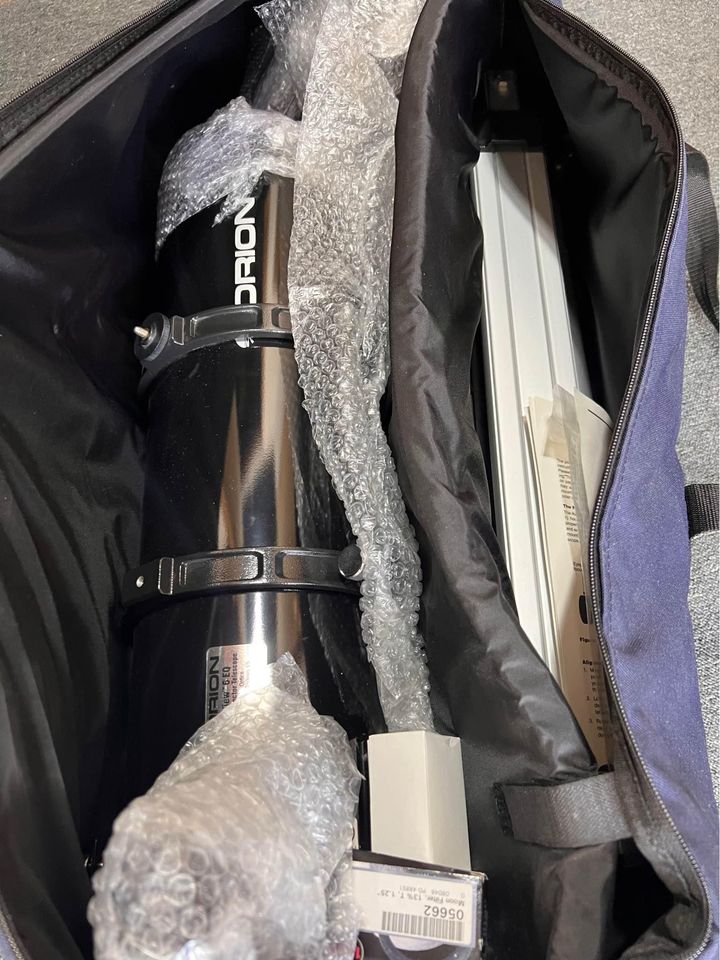The Optical Tube Performance of AstroView 6
The AstroView 6 is a 6” f/5 Newtonian. Compared to a longer scope like the regularly-offered 6” f/8 Dobsonians, the AstroView will be more difficult to collimate and it may show slight amounts of coma at the edge of the field at low power, but it’s still pretty easy to collimate and you’d be hard-pressed to find the coma in the first place, let alone actually care about it.

The AstroView 6 is provided with a 2” all-metal Crayford focuser with a brass compression ring and a 1.25” adapter (which also has T-threads to attach to any T-ring and DSLR/mirrorless camera you wish). A 2” focuser combined with the scope’s short 750mm focal length allows it to achieve a huge field of view with 2” wide-angle eyepieces, though you’ll probably want a coma corrector if you plan on using those.
The scope’s tube rings have a Vixen-style dovetail attached to the bottom, which allows for easy attachment and removal from the mount saddle, and ¼ 20 captive knobs for piggybacking a camera on top of the telescope for wide-field photography.
Are the Accessories Good?
The AstroView 6 comes with two eyepieces: a 25mm Sirius Plossl providing 30x and a 10mm Sirius providing 75x magnification. These are excellent eyepieces, though you may want a 6mm “gold-line” eyepiece and/or a 2x Barlow to get the most magnification this scope offers for lunar and planetary viewing.
Additionally, the AstroView 6 comes with a simple collimation cap to align your optics with, and a 6×30 finderscope. I don’t really care for this 6×30 and would recommend swapping it for a 9×50 finder or Telrad, as the 30mm of aperture makes it hard to see much of anything – it’s arguably harder to use than a zero-power sight like a Telrad!
Aftermarket Accessory Recommendations
The main items we’d recommend adding to the AstroView 6 are a better finderscope and a “6mm “goldline” eyepiece” for higher magnification (125x). For a finder, an 8×50 traditional finderscope, Telrad, Rigel Quikfinder, or an inexpensive red dot sight are all good choices.
The included finder is a simple red dot design, the same as is provided with countless other beginner scopes and really all you need with a small, wide-field instrument like the AstroView 6.
About the AstroView EQ-3 Equatorial Mount
The new AstroView equatorial mount is a woefully undersized design, lacking the cast metal parts, polar scope capability, or beefy tripod legs of the original pre-2022 version. It is shaky, hard to balance, and poorly manufactured, no different from the mounts on many “department store” telescopes. These unfortunate revisions to the AstroView 6 in 2022 continue Orion’s trend of selling radically different and often low-quality products under well-known brand and model names to deceive consumers. Thanks to the low quality of this mount, we simply can’t recommend the AstroView 6 unless you get it cheaply and/or are willing to perform significant DIY modifications to make it more stable.
Astrophotography Capabilities
Any notions of serious astrophotography with the AstroView 6 can be discarded entirely thanks to the bouncy, nearly unusable mount; the lack of any ability to accurately polar align thanks to the removal of the polar scope and hole from its mount; and the difficulties of actually balancing a camera on such a lightweight mount.
Should I buy a Used Orion AstroView 6?
Unless the price is very low and you’re planning on purchasing or building a good mount for it, don’t buy the newer version of the AstroView 6 used. The older, pre-2022 design with square aluminum legs is easy to differentiate and is a great scope.
Alternative Recommendations
For the price of the AstroView 6, we’d also recommend:
- Celestron Omni XLT 150: Vastly superior mount, albeit rather cumbersome and expensive.
- Apertura AD8/Zhumell Z8/Orion SkyLine 8: More aperture, simpler mounting, and better accessories. But Dobsonian design, not EQ.
- Sky-Watcher Virtuoso GTi 150P : A compact, lightweight, and portable scope with a steady mount, GoTo, identical optics, and a lower price tag.
What can you see?
The AstroView 6 is a great wide-field deep-sky instrument thanks to its f/5 focal ratio. It’ll show you lots of open star clusters, begin to resolve the brighter globulars, and deliver fantastic detail in bright nebulae such as the Orion, Lagoon, and Swan, as well as many planetary nebulae such as the Ring, Dumbbell, and Cat’s Eye. Under dark skies, you’ll also be able to delve into viewing many of the brighter galaxies, and some such as M31, M33, M64, and M82, will actually show detail with effort.
Within the Solar System, the AstroView 6 will, of course, show the phases of Venus and Mercury, loads of craters, mountains, ridges, valleys, and other details on the Moon, and the ice caps and dark regions of Mars when it’s close to Earth. Jupiter’s cloud belts, Great Red Spot, and its 4 brightest moons look great, and you’ll be able to see the shadows and disks of the moons when they eclipse or transit the planet. Saturn’s rings, dull cloud bands, and around half a dozen moons are visible, and on a good night, you can see the Cassini Division as a small gap in the rings. Uranus and Neptune are merely pale bluish dots, but with effort, you might just be able to glimpse Neptune’s moon Triton.

